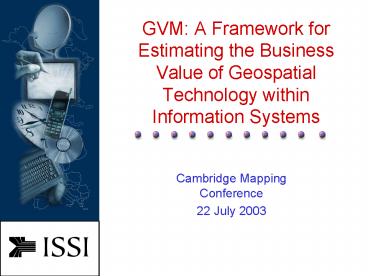GVM: A Framework for Estimating the Business Value of Geospatial Technology within Information Syste - PowerPoint PPT Presentation
1 / 23
Title:
GVM: A Framework for Estimating the Business Value of Geospatial Technology within Information Syste
Description:
Step 2: Process Diagram. 11. Step 3:Set Performance Metrics. 12 ... Measure performance after new information system is implemented on on-going basis. ... – PowerPoint PPT presentation
Number of Views:23
Avg rating:3.0/5.0
Title: GVM: A Framework for Estimating the Business Value of Geospatial Technology within Information Syste
1
GVM A Framework for Estimating the Business
Value of Geospatial Technology within Information
Systems
- Cambridge Mapping Conference
- 22 July 2003
2
Objective
- Develop a practical framework for identifying and
measuring the value of geospatial technology
within enterprise information systems.
3
Problem
- Today, technology decisions and program support
are increasingly based on direct, measurable
business value of technology.
4
Problem
- IT enables business processes rather than
producing direct business results. - ROI measures must accurately show the effect of
IT on business processes.
5
Approach
- Develop a framework that will
- Identify and quantify geospatial technologys
direct contribution to performance metrics. - Produce accurate and continuous ROI data as part
of corporate management processes.
6
GVM Flow
7
Step 0 Adapt GVM framework to Existing IT Design
and Management Methods
- GVM must supplement existing design and
management methods within the organization. - GVM is easy to misuse if treated as stand-alone
method. - GVM is best implemented as an iterative and
participative process.
8
Step 1 Identify Business Process and People
Involved
- E.g. Activate telephone service
9
Whos Involved?
10
Step 2 Process Diagram
11
Step 3Set Performance Metrics
12
Performance Metrics
- Financial
- Productivity
- Customer Value
- E.g. Average time to activate account, customer
churn rate, cost of activation process
13
Step 4 Identify Geospatial Functionality/Data
14
Step 5 Identify Additional Uses (optional)
15
Step 6 Determine Geospatial Specifications
- Data Accuracy, resolution, immediacy, coverage,
- Functions Inputs, storage, edits, queries,
topology, outputs,
16
Identify Geospatial Performance Contribution
17
Assess Alternatives
18
Step 8 Design and Implement
- Use geospatial specifications as input to design
- Data modeling
- Data architecture
- System specification and selection
- Use geospatial specifications in management
parameters - Balanced Scorecard
- Portfolio Management
- Clients corporate management process
19
Step 9 Measure Performance
- Measure baseline performance.
- Measure performance after new information system
is implemented on on-going basis. - See ROI Worksheet.
20
Step 10 Adjust/ Act
21
Issues and Constraints
- GVM is a prototype
- Metrics v. causation
- Easy to overestimate value
- GVM does not capture intangible value
22
Conclusions
- The business value of geospatial technology can
be identified and assessed. - Measurement requires that the role of geospatial
technology be considered throughout the design
and implementation of business processes and the
information systems that support them.
23
(No Transcript)































